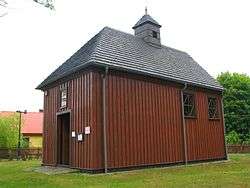Blizno, Kuyavian-Pomeranian Voivodeship
Blizno [ˈbliznɔ] is a village in the administrative district of Gmina Książki, within Wąbrzeźno County, Kuyavian-Pomeranian Voivodeship, in north-central Poland.[1]
Blizno | |
|---|---|
Village | |
 | |
 Blizno | |
| Coordinates: 53°22′51″N 19°4′36″E | |
| Country | |
| Voivodeship | Kuyavian-Pomeranian |
| County | Wąbrzeźno |
| Gmina | Książki |
History
Blizno and Blizienko are villages, located by the road Radzyń Chełmiński – Jabłonowo Pomorskie, are mentioned in historical sources for the first time towards the end of the 13th century. These two villages border on each other and the border between them runs near the bridge which separates two lakes. Meinhard Von Queufurt, the country master of the Order of Teutonic Knights, granted 34 włóka in Blizno to a men named Mirogniew. At that time, Blizienko was owned by Jan from Blizienko, and in the mid-14th century the Order of Teutonic Knights founded in its area a manor subordinate to the castle in Radzyń. Jan, the village leader of Blizienko (sołtys), gained sołectwo and 4 włóka of arable land free from rent in the village Zielnowo from the Order of Teutonic Knights in 1365. Blizno had 8 free włóka, but it was partially abandoned after the war in 1414. 8 local peasants were killed and the Order of Teutonic Knights estimated the losses at 1400 grzywna (a monetary unit). A few interesting facts come from 1570 – there was an inn, also a brewer and a blacksmith lived in the village. Augustyn, the village leader, was cultivating 8 włóka free from rent, according to the old privilege. King Sigismund Augustus granted the village leader a right to fish in lake Jędro, collect dry wood in the forest and a right to profits from the inn. Both villages, Blizno and Blizienko, belonged to the parish in Rywałd and both during the period of the Partitions of Poland were colonised by Germans. According to information from the second half of the 19th century, only 29 out of 308 inhabitants of Blizno were Poles. However, in Blizienko there were more than 100 out of 182 inhabitants were of Polish nationality. [2]
References
- "Central Statistical Office (GUS) - TERYT (National Register of Territorial Land Apportionment Journal)" (in Polish). 2008-06-01.
- "Urząd Gminy Książki" (in Polish). 2010-07-14. Archived from the original on 2012-03-09.